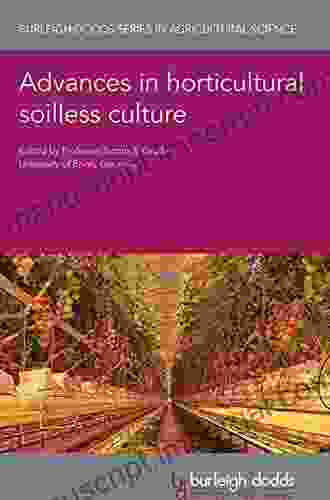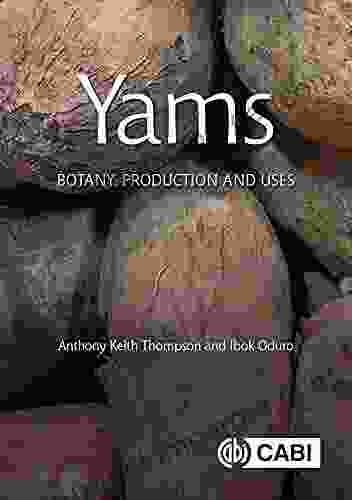Unlock the Secrets of Yams: A Comprehensive Guide to Botany, Production, and Uses

Yams (Dioscorea spp.) are a diverse group of edible tubers that have been cultivated for centuries across tropical and subtropical regions worldwide. These nutrient-rich vegetables are not only a staple food source but also possess a wide range of medicinal and industrial applications. "Yams: Botany, Production, and Uses" is an in-depth guide that delves into the fascinating world of these versatile plants.
Botany of Yams
Taxonomy and Morphology
Yams belong to the genus Dioscorea, which comprises over 600 species. They are typically herbaceous vines, although some species may be shrubby or woody. The stems of yams are often twining or creeping, and they produce tubers at the base or along the root system. These tubers vary greatly in size, shape, and color, depending on the species.
4.6 out of 5
| Language | : | English |
| File size | : | 11578 KB |
| Text-to-Speech | : | Enabled |
| Screen Reader | : | Supported |
| Enhanced typesetting | : | Enabled |
| Print length | : | 639 pages |
| Lending | : | Enabled |
Leaf Structure
Yam leaves are simple and alternate, with a wide range of shapes and sizes. They are typically ovate or heart-shaped, with entire or lobed margins. The leaf veins are often palmate, radiating from the base of the leaf towards the apex.
Floral Structures
Yams produce unisexual flowers, meaning male and female flowers occur on separate plants. The inflorescences are usually axillary, with numerous flowers clustered together. The male flowers have six stamens, while the female flowers have a single pistil.
Tuber Formation and Development
Yams develop tubers as a means of storing carbohydrates and nutrients. The tubers form at the base of the stem or along the roots, and they consist of a starchy interior covered by a thin, brown skin. The tuber's size and shape vary depending on the species and growing conditions.
Production of Yams
Environmental Requirements
Yams require warm, humid climates with ample rainfall. They prefer well-drained soils with a pH between 5.5 and 6.5. The optimal temperature range for yam growth is between 22 and 30°C.
Propagation Techniques
Yams are propagated vegetatively using either whole seed tubers or tuber pieces. Whole seed tubers are less prone to disease and produce more vigorous plants, but they require more storage space. Tuber pieces, on the other hand, can be planted more densely and are less likely to be damaged during storage.
Cultivation Practices
Yam cultivation involves preparing the soil, planting the tubers, and providing proper care during growth. The tubers are typically planted in ridges or mounds to ensure good drainage. They should be spaced appropriately to allow for proper vine development. Regular watering, weeding, and pest control are essential for optimal yield.
Harvesting and Storage
Yams are harvested when the leaves start to turn yellow and the tubers are fully mature. The tubers should be carefully dug up and allowed to cure in a warm, dry location for a few days before storage. Yam tubers can be stored for several months under the right conditions, such as a cool, dark, and well-ventilated area.
Uses of Yams
Culinary Uses
Yams are versatile vegetables that can be cooked in various ways. They can be boiled, roasted, fried, or mashed. The cooked flesh is starchy and has a slightly sweet flavor. Yams are a good source of energy and fiber, and they can be incorporated into a wide range of dishes.
Medicinal Uses
Yams have been traditionally used in various cultures for medicinal purposes. They are known to possess anti-inflammatory, antioxidant, and immune-boosting properties. In particular, the tuber's mucilage has been found to have wound-healing and gastrointestinal benefits.
Industrial Uses
Yam starches and flours are widely used in the food industry as thickening agents, stabilizers, and binders. They are also used in the production of adhesives, paper, and textiles. Additionally, yam tubers are a potential source of biofuel, as they contain high levels of carbohydrates.
"Yams: Botany, Production, and Uses" is a comprehensive resource that provides detailed information on the botany, production, and uses of yams. This book is a valuable asset for researchers, farmers, and anyone interested in the cultivation and utilization of these versatile vegetables. By understanding the science and practices behind yam production, we can optimize their growth and unlock their full potential as a food source, a therapeutic agent, and an industrial material.
4.6 out of 5
| Language | : | English |
| File size | : | 11578 KB |
| Text-to-Speech | : | Enabled |
| Screen Reader | : | Supported |
| Enhanced typesetting | : | Enabled |
| Print length | : | 639 pages |
| Lending | : | Enabled |
Do you want to contribute by writing guest posts on this blog?
Please contact us and send us a resume of previous articles that you have written.
 Book
Book Novel
Novel Page
Page Chapter
Chapter Text
Text Story
Story Genre
Genre Reader
Reader Library
Library Paperback
Paperback E-book
E-book Magazine
Magazine Newspaper
Newspaper Paragraph
Paragraph Sentence
Sentence Bookmark
Bookmark Shelf
Shelf Glossary
Glossary Bibliography
Bibliography Foreword
Foreword Preface
Preface Synopsis
Synopsis Annotation
Annotation Footnote
Footnote Manuscript
Manuscript Scroll
Scroll Codex
Codex Tome
Tome Bestseller
Bestseller Classics
Classics Library card
Library card Narrative
Narrative Biography
Biography Autobiography
Autobiography Memoir
Memoir Reference
Reference Encyclopedia
Encyclopedia Lisa Dianne Mcinnes
Lisa Dianne Mcinnes Charlotte Smith
Charlotte Smith J A Pintozzi
J A Pintozzi Lesley Crossingham
Lesley Crossingham Chase Hassen
Chase Hassen Christopher Harlan
Christopher Harlan Ramaji
Ramaji Peter Linebaugh
Peter Linebaugh Chris Graham
Chris Graham Cornel West
Cornel West Martin Travis
Martin Travis Dr Nitika Sobti
Dr Nitika Sobti Kerri P Steinberg
Kerri P Steinberg Charles M Sevilla
Charles M Sevilla Christopher M Gillen
Christopher M Gillen Sergio Pistoi
Sergio Pistoi Cherilyn Orr
Cherilyn Orr Danny Bernstein
Danny Bernstein Hope Holloway
Hope Holloway Chris Letheby
Chris Letheby
Light bulbAdvertise smarter! Our strategic ad space ensures maximum exposure. Reserve your spot today!

 Fabian MitchellClinical Guide To Diagnosis And Management: Your Essential Guide to Accurate...
Fabian MitchellClinical Guide To Diagnosis And Management: Your Essential Guide to Accurate...
 Haruki MurakamiAdvance Your Horticultural Skills with "Advances in Horticultural Soilless...
Haruki MurakamiAdvance Your Horticultural Skills with "Advances in Horticultural Soilless... Philip BellFollow ·18.8k
Philip BellFollow ·18.8k Cooper BellFollow ·17k
Cooper BellFollow ·17k Dwayne MitchellFollow ·11.9k
Dwayne MitchellFollow ·11.9k Keith CoxFollow ·6.7k
Keith CoxFollow ·6.7k Gilbert CoxFollow ·17.2k
Gilbert CoxFollow ·17.2k Gerald BellFollow ·19.4k
Gerald BellFollow ·19.4k Fletcher MitchellFollow ·16.9k
Fletcher MitchellFollow ·16.9k Heath PowellFollow ·6.1k
Heath PowellFollow ·6.1k

 E.E. Cummings
E.E. CummingsOne Man's Story of What It Meant to be Pj
In the tapestry of life,...

 Caleb Long
Caleb LongPattern Theory in Video Keno: Unveiling the Art of...
Embark on an enlightening journey into the...

 Douglas Adams
Douglas AdamsUnveiling the Diplomatic Landscape: The Ottoman Empire,...
Delving into the History...

 Terry Bell
Terry BellThere Still Is No Off Season: Embracing Year-Round...
In a world consumed by routine and the allure...

 Ibrahim Blair
Ibrahim BlairBrain Teasers Games and Puzzles: Exercise Your Mind with...
Prepare to embark on a captivating journey...
4.6 out of 5
| Language | : | English |
| File size | : | 11578 KB |
| Text-to-Speech | : | Enabled |
| Screen Reader | : | Supported |
| Enhanced typesetting | : | Enabled |
| Print length | : | 639 pages |
| Lending | : | Enabled |










